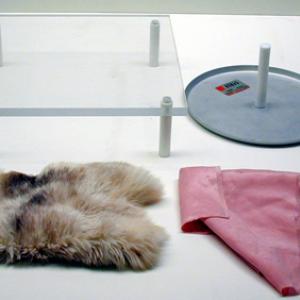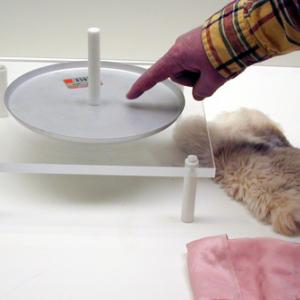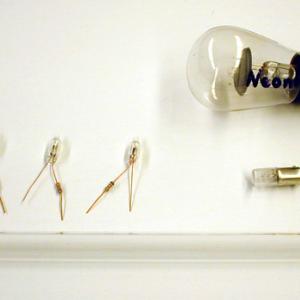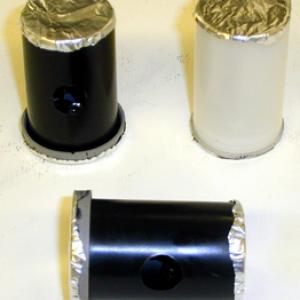College of Liberal Arts & Sciences
5A10.20 - Electrophorus
Charge the electrophorus plate by rubbing it with the cats fur. This plate will have a positive charge when this is done. Set the charging plate onto the electrophorus and draw a spark off the back of the plate with your finger. Remove the charging plate from the electrophorus and you should now have a negative charge. The electrophorus should stay charged for several cycles of the charging and discharging operation.
The film canisters contain a neon light that will flash in the presence of an electrostatic field.
- Robert A. Morse, "Simple Pencil-and-Paper Notation for Representing Electrical Charge States", The Physics Teacher, November 2017, volume 55, pg. 470.
- David R. Lapp, "Bigger Cap... Bigger Spark", TPT, Vol. 30, # 8, Nov. 1992, p. 454.
- William R. Gregg, "Three Inexpensive High-Voltage Electricity Demonstrations", TPT, Vol. 30, # 7, Oct. 1992, p. 400 - 401.
- William Layton, "A Different Light on an Old Electrostatics Demonstration", TPT, Vol. 29, # 1, p. 50, Jan. 1991.
- R. A. Morse, "The Automatic Electrophorous", TPT, Vol. 29, # 4, Apr. 1991, p. 225.
- R. D. Edge, "Electrostatics With Soft-Drink Cans", TPT, Vol. 22, # 6, Sept. 1984, p. 396 - 398.
- Donald S. Ainslie, "Can an Electrophorus Lose Its Charge and then Recharge Itself ?", TPT, Vol. 20, # 4, Apr. 1982, p. 254.
- Donald S. Ainslie, "Inversion of Electrostatic Charges in a Cylindrical Electrophorus", TPT, Vol. 18, # 7, Oct. 1980, p. 530.
- Oleg Jefimenko, David Walker, "Electrets", TPT, Vol. 18, # 9, Dec. 1980, p. 651.
- John E. Girard, "Negative Charges from an Electrophorus", TPT, Vol. 16, # 6, Sept. 1978, p. 402.
- John W. Layman and Delbert J. Rutledge, "Neon Lamps and Static Electricity", TPT, Vol. 10, # 1, Jan. 1972, p. 49.
- Tom B. Greenslade, Jr., "Electrophorus", AJP, Vol. 92, #10, Oct. 2024, p. 774.
- Thomas B. Greenslade, Jr., "Electrophorus" (Photo), AJP, Vol. 79, # 1, Jan. 2011, p. 102.
- D. S. Ainslie, "What are the Essential Conditions for Electrification by Rubbing?", AJP, Vol. 35, # 6, June 1967, p. 535.
- Ea-19: Freier and Anderson, A Demo Handbook for Physics.
- E-140: "Electrophorus", DICK and RAE Physics Demo Notebook.
- E-10: Richard Manliffe Sutton, Demonstration Experiments in Physics.
- Tik Liem, "The Spark - Producing Finger", Investigation to Science Inquiry, p. 246.
- Robert A. Morse, "Laboratory Activity 6: Neon Bulbs and Motion of Charge", Teaching about Electrostatics, p. 3 - 17.
- Robert A. Morse, "Laboratory Activity 3: The Electrophorus and Charging by Induction", Teaching about Electrostatics, p. 3 - 9.
- George M. Hopkins, "Frictional Electricity", Experimental Science, p. 368.
- John Henry Pepper, "Electrophorus", Cyclopadic Science Simplified, p. 245.
- Carson I. A. Ritchie, "Electrophorus", Making Scientific Toys, p. 149.
- Pat Murphy, Ellen Macaulay, and the staff of the Exploratorium, "Super Sparker - The Electrophorus", Exploratopia, p. 327.
- David Kutliroff, "77, The Electrophorus - An Ancient Charging Device", 101 Classroom Demonstrations and Experiment For Teaching Physics, p. 169.
- "Charge and Carry", Science Snackbook, p. 20.1 - 20.3.
- Robert DeSerio, "Electrostatics - Lab Experiment", Dept. of Physics, Univ. of Florida, 2012.
- Grant Mellor, "Tiny Shocks", Flying Tinsel, 1993, p. 33 - 37.
- Grant Mellor, "A Second Look", Flying Tinsel, 1993, p. 44 - 47.
- Grant Mellor, "Quick as a Wink", Flying Tinsel, 1993, p. 56 - 59.
- Rudolf F. Graf, "Charge a Balloon", Safe and Simple Electrical Experiments, p. 3.
- Rudolf F. Graf, "Drawing Sparks From a Dry Newspaper", Safe and Simple Electrical Experiments, p. 6.
- Rudolf F. Graf, "Building an Electrophorus", Safe and Simple Electrical Experiments, p. 16.
- Rudolf F. Graf, "Using an Electrophorus", Safe and Simple Electrical Experiments, p. 17.
- Joseph Frick, "# 269 - The Electrophorus", Physical Technics: Or Practical Instructions for Making Experiments in Physics and the Construction of Physical Apparatus with the Most Limmited Means, p. 303.
- "The Electrophorus", Pike's Illustrated Catalogue of Scientific & Medical Instruments, 1984, p. 258.
Disclaimer: These demonstrations are provided only for illustrative use by persons affiliated with The University of Iowa and only under the direction of a trained instructor or physicist. The University of Iowa is not responsible for demonstrations performed by those using their own equipment or who choose to use this reference material for their own purpose. The demonstrations included here are within the public domain and can be found in materials contained in libraries, bookstores, and through electronic sources. Performing all or any portion of any of these demonstrations, with or without revisions not depicted here entails inherent risks. These risks include, without limitation, bodily injury (and possibly death), including risks to health that may be temporary or permanent and that may exacerbate a pre-existing medical condition; and property loss or damage. Anyone performing any part of these demonstrations, even with revisions, knowingly and voluntarily assumes all risks associated with them.



